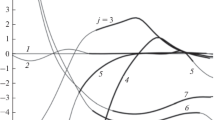Abstract
We discuss properties of nuclear reactions (branching ratios, reaction constants, etc.) between hydrogen isotopes from the standpoint of recent R-matrix calculation.. Using R-matrix theory to include nuclear effects at small distances, we then develop a general expression for fusion rates in complex systems that, in principle, allows a more complex interplay of the short-ranged (nuclear) and long-ranged (screened Coulomb) forces than does the familiar separable form. Calculations using the latest nuclear R-matrix information in this more correct formulation appear to agree with the separable approximation for screened Coulomb potentials of the Hulthén form, however. They indicate that fusion rates of the order of 10−24s−1 require unreasonably large electron densities if they are to result from screening in the lattice, and are more likely to arise from non-equilibrium processes producing particles with relative energies greater than 100 eV.
Similar content being viewed by others
References
E. P. Wigner and L. Eisenbud (1947),Phys. Rev.,72, 29; A. M. Lane and R. G. Thomas (1958),Rev. Mod. Phys.,30, 257.
G. M. Hale and D. C. Dodder (1980). R-Matrix Analysis of Light-Element Reactions for Fusion Applications. Proceedings of the Conference on Nuclear Cross Sections for Technology, Knoxville, Tennessee, 1979, NBS Special Publication594, (1980), p. 650.
C. A. Barnes (1971). Nucleosynthesis by charged-particle reactions. InAdvances in Nuclear Physics (Vol. 4, Chap. 3), M. Baranger and E. Vogt, eds. (Plenum Press, New York).
C. R. Chen, G. L. Paine, J. L. Friar, and B. F. Gibson (1989).Phys. Rev. C,39, 1261.
J. L. Langenbrunner G. Feldman, and H. R. Weller (1989). Two deuteron radiative capture: Polarization observables form Ed≤0.8 MeV to Ed=15 MeV.Phys. Rev. C (submitted).
W. A. Fowler, G. R. Caughlin, and B. A. Zimmerman (1967).Ann. Rev. Astron. Astrophys. 5, 525.
R. E. Brown and N. Jarmie (1989). Phys. Rev. C42, 1391.
A. Krauss, H. W. Becker, H. P. Trautvetter, and C. Rolfs (1987).Nucl. Phys.,A465, 150.
R. M. Witton (1989). Ph.D. thesis, Duke University.
D. V. Balinet al. (1984).Phys. Lett.,141B, 173,JETP Lett.,40, 112.
B. P. Adyasevich, V. G. Antonenko, and V. N. Bragin (1981).Yad. Fiz.,33, 1167 (Sov. J. Nucl. Phys.,33, 619).
G. M. Hale and D. C. Dodder (1989). Charge-Independent Description of the d+d Reactions, Reports to the DOE Nuclear Data Committee.
J. D. Jackson (1957).Phys. Rev.,106, 330.
S. E. Joneset al. (1989).Nature,338, 737.
Author information
Authors and Affiliations
Rights and permissions
About this article
Cite this article
Hale, G.M., Smith, R.D. & Talley, T.L. Nuclear reactions and screened-coulomb fusion rates. J Fusion Energ 9, 187–193 (1990). https://doi.org/10.1007/BF02627583
Issue Date:
DOI: https://doi.org/10.1007/BF02627583




